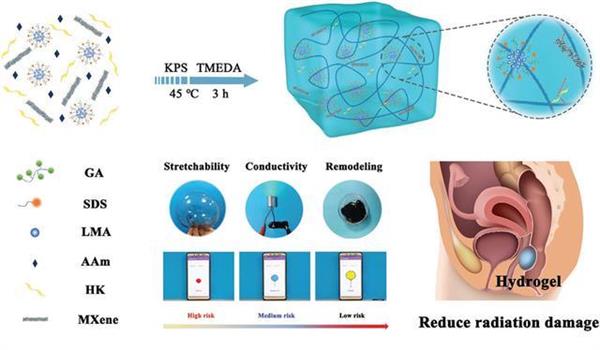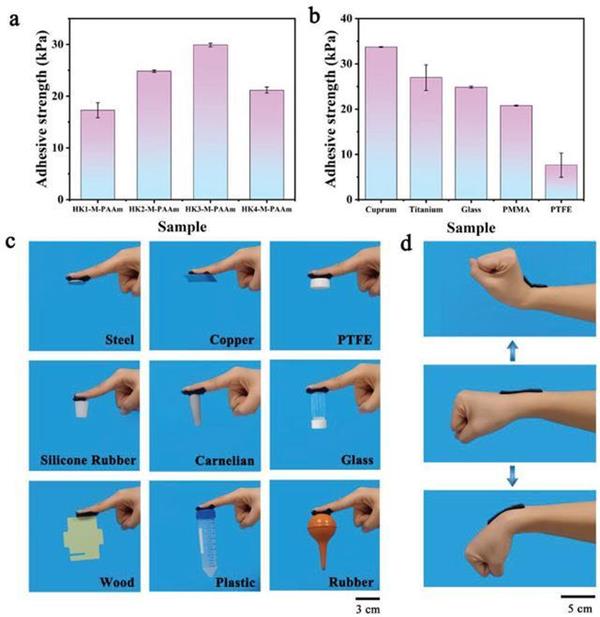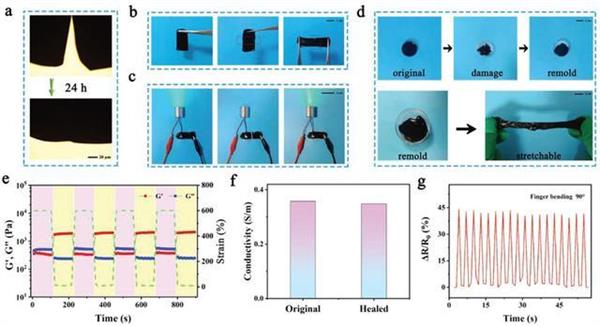Introduce
Today, smart electronics have recently generated a lot of interest in electronic skin, soft robotics, medical implants, and wearables. Intelligent bionic electronic products benefit from their inherent superior perception ability, which can detect external stimuli and convert their changes into electrical signals that can be recorded. They are widely used in the fields of human daily motion detection, skin perception, intelligent prosthetics and robotics. Typically, conventional flexible electronics manufacture conductive channels in the system by embedding conductive fillers into elastomers or integrating semiconductors into flexible thin metal substrates. Unfortunately, low stretchability, low sensitivity and narrow sensing range have seriously hindered the further development of flexible electronics. Therefore, the development of flexible smart sensors with detection and protection functions is highly desirable and remains a huge challenge.
Abstract
Recently, conductive hydrogels have attracted much attention in biomedical and intelligent electronics fields. Although existing conductive hydrogels have multiple functions, it is still a challenge to introduce hydrogels to regulate the distance between peritumoral organs and tumors and reduce radiation damage to peritumoral organs. Recently, hydrophobic associating hydrogels with many desirable characteristics have been fabricated based on different supramolecular assemblies. The introduction of MXene and hydrolyzed keratin (HK) gives the hydrogel excellent electrical conductivity, supertensile (>2000%) and good self-viscosity. In addition, hydrogels are used as smart sensors for monitoring various human movement and physiological signals, with a wide strain window, fast response time (130 ms) and excellent strain sensitivity (GF = 10.22).
Preparation of hydrogel and mechanical test
Hydrophobic associating hydrogel HK-M-PAAM was designed and prepared. Acacia gum (GA) and sodium dodecyl sulfonate (SDS) were introduced into the hydrogel as composite surfactants to provide stability against drople aggregation. At the same time, the micelles formed by composite surfactants play a role of dynamic physical cross-linking, which endods HK-M-PAAM hydrogel with good self-healing and remodeling ability. In addition, the introduction of hydrolyzed keratin (HK) not only increased the ductility of hydrogels, but also gave them excellent adhesion, enabling them to bond tightly to different substrates through hydrogen bonding, hydrophobic interaction, metal complexation and electrostatic interaction. The presence of MXene makes the hydrogel have excellent electrical conductivity, and a large number of hydrophilic groups on the surface of MXene can serve as a bridge connecting PAAm and HK, effectively improving the mechanical properties of the hydrogel.

Figure 1: Schematic diagram of preparation process and application of HK-M-PAAM hydrogel.

Figure 2: A,b) Mechanical test of HK-M-PAAM hydrogel, including balloon blowing, stretching and knotting stretching; C) G 'and G "of m-PAAM, HK-PAAM and HK-M-PAAM hydrogels; D) Tensile curves of M-PAAM, HK-PAAM and HK-M-PAAM hydrogels; E) Corresponding stress and toughness of m-PAAM, HK-PAAM and HK-M-PAAM hydrogels; F) Corresponding strain and elastic modulus of m-PAAM, HK-PAAM and HK-M-PAAM hydrogels; G) Tensile curves of HK-M-PAAM hydrogel with different HK contents; H) The corresponding stress and toughness of HK-M-PAAM hydrogel with different HK contents; I) corresponding strain and elastic modulus of HK-M-PAAM hydrogel with different HK contents.
High adhesion and self-healing
Hydrogels show remarkable adhesion to various substrates such as Cu, Ti, glass, PMMA and PTFE, and the bonding strength is affected by the content of HK. With the increase of HK content from 25% to 75% of monomer content, the adhesive strength of hydrogel gradually increased. When the mass ratio of HK/AAm was 75 wt%, hK-M-PAAM hydrogel showed the best adhesion, and the adhesion strength reached 29.88 kPa. When hK-M-PAAM hydrogel was cut into two pieces, it healed after 24 hours. When the damaged surface was contacted for 24h, the damaged hydrogel healed completely and could withstand a certain tension. The self-healing behavior is mainly caused by the recombination of micelles and the hydrogen bond on the fractured surface. These dynamic physical interactions can effectively promote the movement between chain segments and endue hydrogels with fast and excellent self-healing ability.

Figure 3: a) Bonding strength of HK-M-PAAM hydrogels with different PROPORTIONS of HK on glass substrate; B) Bonding strength of HK-M-PAAM hydrogel on different substrate materials; C) Demonstration of excellent adhesion of HK-M-PAAM hydrogel to various organic and inorganic materials (including steel, rubber, glass, wood, carnelian and plastic, etc.); D) Photos of close contact between hydrogel and non-flat skin during dynamic wrist movement.

Figure 4: Self-healing properties of HK-M-PAAM hydrogel: a) Light microscope photos of hK-M-PAAM hydrogel before and after self-healing at 24 h; B) Photos before and after self-healing of HK-M-PAAM hydrogel and stretching display of self-healing hydrogel; C) Photos of electrical conductivity of HK-M-PAAM hydrogel before and after self-healing; D) Recyclability of damaged HK-M-PAAM hydrogel and tensile properties of reconstructed hydrogel; E) Step strain measurement of hydrogels with a fixed frequency of 10 RAD S-1; F) Electrical conductivity of HK-M-PAAM hydrogel before and after self-healing; G) Self-healing hydrogel responds to changes in relative resistance of 90° finger bending.
Sensor
In addition, excellent self-healing properties can cope with mechanical damage caused by repeated bending and stretching, thus improving durability in practical applications. The optical microscope image is shown in FIG. 4A to visually demonstrate the self-healing process. When the damaged surface of HK-M-PAAM hydrogel was contacted for 24 h, the damaged hydrogel healed completely and could withstand a certain tension (Figure 4b). Hk-m-paam hydrogel and green LED indicator light are connected to form the self-healing process of a complete circuit, as shown in FIG. 4C. As shown in Figure 4D, the complete HK-M-PAAM hydrogel is cut into fragments, which can be easily re-formed and the re-formed hydrogel can withstand tensile deformation.

Figure 5: Characterization of hydrogel sensors. A) Changes in relative resistance and GF of HK-M-PAAM hydrogel sensor under different tensile strains (0-1000%); B) Response and recovery time of HK-M-PAAM hydrogel sensor to strain; C) Comparison of the scope and sensitivity of this work with the reported literature; D-f) Changes in relative resistance of hK-M-PAAM hydrogel sensor during repeated stretching under small strain (0-5%), medium strain (10-100%) and large strain (100-500%). G) Stability test of HK-M-PAAM hydrogel sensor under 200 loading-unloading cycles; H) (g) enlarged view of the red box.
(Source:High Polymer)
Technological innovation
Honesty is the foundation
Contact Number: +86-15698999555 |
Address: NO.6 ,SHENGHUA STREET,TAIHE DISTRICT, JINZHOU CITY, LIAONING PROVINCE, CHINA. |